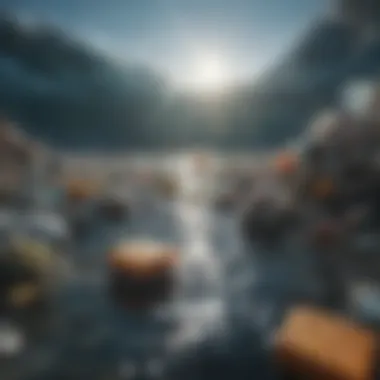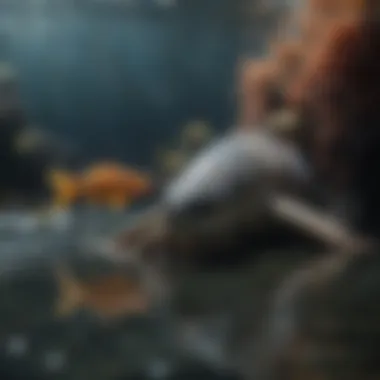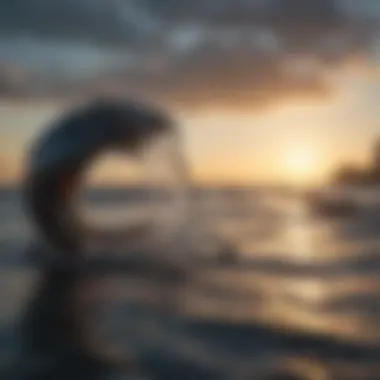Assessing the Plastic Pollution Crisis in Our Oceans


Intro
Plastic pollution in our oceans is a critical environmental issue that demands immediate attention. With over 300 million tons of plastic produced annually, a significant portion ends up in marine environments. Understanding the scope of this problem is crucial for developing effective solutions. This article will assess the extent of plastic pollution, its sources, and the devastating impacts it has on marine ecosystems.
The key points that will be explored include the statistics surrounding plastic contamination, the primary contributors to this pollution, and the resulting effects on wildlife. Further, we will evaluate ongoing initiatives aimed at tackling this crisis and the collaborative efforts required to foster sustainable change.
By examining these elements, the aim is to engage an audience eager to comprehend and address the global challenge of plastic waste in our oceans.
Preface to Oceanic Plastic Pollution
The issue of oceanic plastic pollution is neither new nor trivial. Its increasing prevalence in our waterways has prompted urgent discussions about environmental stewardship. Understanding this crisis is vital for both ecological health and human well-being. Plastic pollution impacts marine life significantly and has various secondary effects on the ecosystems that depend on healthy oceans. Moreover, insights into this pressing matter are crucial for informing policy decisions, fostering community action, and promoting sustainable practices among individuals and industries alike.
Overview of Ocean Pollution
Ocean pollution refers to the introduction of harmful substances into marine environments. These pollutants come in various forms, with plastics being a considerable concern. Plastics, because of their durability and versatility, have proliferated in daily life. However, this same durability makes them resistant to degradation once discarded. Consequently, plastics persist in oceans for hundreds of years, leading to severe ecological consequences.
As plastics break down into smaller pieces, known as microplastics, they become less visible yet more insidious. These particles infiltrate various marine organisms, from plankton to larger species, including fish and mammals. As a result, plastic pollution is now recognized as a critical threat to biodiversity and ecosystem integrity.
Current Statistics on Plastic Presence
Recent studies indicate alarming statistics regarding plastic presence in oceans. According to the United Nations Environment Programme, an estimated 13 million tons of plastic enter the marine environment each year. This statistic underscores the scale of the problem and emphasizes the need for immediate attention. Currently, scientists estimate over 150 million tons of plastic is floating in our oceans, a figure that continues to rise.
"Plastic pollution has been identified as one of the most pressing environmental challenges of our time."
Key figures further illustrate this crisis:
- Over 800 species are documented to be affected by plastic pollution.
- Coastal regions, particularly in Southeast Asia, are among the most impacted, where mismanaged waste contributes significantly to oceanic plastic waste.
- Studies show that 90% of ocean debris is plastic, highlighting the urgent need for awareness and action.
These statistics serve not just as numbers, but as exponential indicators of behavior change necessary across all demographics. The urgency is clear, as the impact reaches far beyond the water’s surface.
Quantification of Plastic in Marine Environments
Quantifying the extent of plastic pollution in marine environments is crucial for several reasons. It provides a clear understanding of the problem's scale and helps track the effectiveness of measures taken to combat it. This quantification informs policymakers, scientists, and the public about where efforts must be concentrated. Without precise data, efforts may be misdirected or insufficient.
Understanding the Percentages
Plastic constitutes a significant percentage of marine debris. Recent studies suggest that up to 80% of all debris found in the ocean is plastic. In some regions, microplastics—pieces smaller than five millimeters—account for a large portion. Assessing these percentages is not just about numbers; it conveys the urgency of the situation. Knowing that millions of tons of plastic enter the oceans annually drives home the necessity for immediate action.
By studying trends such as the increase of plastic pollution over time, we can highlight the severity of the crisis. In particular, urban runoff, along with improper waste management, plays a crucial role in the accumulation of plastics in marine environments. It is also necessary to consider that different regions exhibit varying percentages of plastic waste.
Types of Marine Plastic Debris
The types of marine plastic debris are diverse and each category poses unique challenges. Some common forms include:
- Plastic Bags: These are lightweight and easily carried by wind and water. Their presence is often seen along shorelines.
- Straws and Cutlery: Single-use plastics are significant contributors to oceanic pollution, quickly degrading habitats.
- Fishing Gear: Abandoned nets create ghost nets that entrap marine life.
- Microplastics: These are fragments from larger plastics that degrade over time. They are pervasive and difficult to remove.
Understanding these types aids in pinpointing sources and developing targeted solutions. > "Not all plastic debris affects marine life equally, but every piece counts toward the overall crisis."
Closure
Quantifying plastic in our oceans is the groundwork for effective problem-solving. By examining percentages and types of plastic, stakeholders can track progress and innovate new strategies for marine protection. Each data point serves as a call to action for individuals, communities, and governments alike.


Sources of Oceanic Plastic Pollution
Understanding the sources of plastic pollution in our oceans is critical for developing effective solutions to this pressing environmental crisis. The vast majority of marine plastic originates from land-based and sea-based activities. Each source contributes uniquely to the problem, representing various challenges and opportunities for mitigation. By examining these sources, we can better comprehend the complexity of plastic pollution and implement more focused interventions.
Land-Based Contributions
Land-based sources contribute significantly to oceanic plastic pollution. A staggering amount of plastic waste comes from urban areas, where improper waste management practices are prevalent. Inadequate recycling facilities and littering amplify this issue.
- Urban Activities: Trash discarded by individuals often ends up in waterways, eventually making its way to the ocean. Popular items that contribute to this are plastic bags, bottles, and food wrappers.
- Industrial Discharges: Manufacturing sectors sometimes release plastic waste into water bodies, whether intentionally or unintentionally.
- Agricultural Practices: The use of plastic in agricultural activities, such as mulch films and pesticides, adds to the plastic burden. When these materials break down, microplastics can enter marine systems.
Efforts to address these land-based contributions include:
- Improved Waste Management: Investing in recycling and waste treatment facilities helps reduce the flow of plastic into the ocean.
- Public Education: Knowledge campaigns can encourage individuals to minimize plastic use and improve personal disposal practices.
- Legislation: Governments can implement stricter regulations for waste management and production of single-use plastics.
Sea-Based Contributions
Sea-based contributions to plastic pollution arise primarily from maritime activities. These sources are often overlooked, yet they present substantial challenges.
- Shipping Industry: Cargo ships and vessels can lose containers at sea, leading to significant amounts of plastic debris entering the ocean. There also might be litter dropped from ships directly.
- Fishing Activities: Abandoned fishing gear, such as nets and lines, contributes notably to marine plastic. These materials can trap and kill marine life for years.
- Tourism and Recreation: Activities associated with tourism, including beaches and marine sports, often result in littering. Tourists may not always recognize the importance of maintaining a clean environment.
Addressing sea-based contributions involves:
- Stricter Regulations: Implementing and enforcing laws regarding waste disposal for vessels can reduce direct ocean littering.
- Cleanup Initiatives: Organized efforts to clean beaches and waters can mitigate existing pollution while promoting awareness about ocean health.
- Innovative Solutions: Encouraging the development of sustainable fishing gear can help reduce the amount of plastic waste generated by marine industries.
"To tackle the plastic crisis effectively, we must understand the myriad sources that contribute to the problem. Only then can we develop targeted strategies to combat this issue."
By comprehensively addressing both land-based and sea-based contributions to plastic pollution, steps can be taken toward alleviating this global crisis. The focus now shifts to the regional variations in plastic concentration and their impacts on vulnerable ecosystems.
Regional Variations in Plastic Concentration
Understanding the regional variations in plastic concentration is crucial for grasping the full extent of oceanic plastic pollution. Different areas exhibit varying levels of pollution, influenced by factors such as population density, waste management practices, and ocean currents. These variations are important for several reasons. First, they help scientists and policymakers identify high-risk regions that may require immediate intervention. Second, they provide insight into how plastic accumulates and disperses within marine environments. This knowledge aids in developing targeted strategies to address the specific needs of these areas. Lastly, examining regional differences can enhance global collaboration and support sharing best practices to combat ocean plastic pollution effectively.
Areas of High Concentration
Certain regions of the ocean are notable for exceptionally high concentrations of plastic debris. These areas often include coastal regions near urban centers, where large populations contribute significantly to waste. Notable examples include:
- The Great Pacific Garbage Patch: This region between Hawaii and California is notorious for its massive accumulation of plastic, influenced by prevailing ocean currents.
- Mediterranean Sea: High traffic from boats and surrounding cities leads to alarming levels of plastic, impacting marine life considerably.
- Bay of Bengal: This area faces severe pollution due to both land-based and marine activities, causing dire consequences for local ecosystems.
Exploring these regions helps bring attention to the urgent need for localized cleanup efforts and prevention strategies. Recognizing the specific characteristics of these concentration points is the first step towards devising impactful solutions.
Impact on Vulnerable Ecosystems
The impact of plastic pollution is not uniform; its effects can drastically differ depending on the region. Vulnerable ecosystems, such as coral reefs, mangroves, and coastal wetlands, are especially susceptible to the negative consequences of plastic debris. The implications include:
- Disruption of Marine Life: Animals often ingest plastic or become entangled, leading to injury or death. This disrupts the natural food web.
- Habitat Degradation: Accumulation of plastic can damage sensitive habitats, such as coral reefs, reducing their resilience to climate change.
- Toxicity Issues: Some plastics break down into microplastics, which can introduce harmful chemicals into the food chain, potentially affecting human health.
It is essential to monitor these impacts closely. By understanding the consequences of plastic in high-concentration areas, we can better protect these fragile ecosystems and foster more sustainable global marine practices.
"Addressing the regional variations in plastic concentration is paramount to not only safeguarding marine ecosystems but also ensuring the well-being of communities that depend on these resources."
Recognizing the complex interactions between plastic pollution and various marine environments encourages a comprehensive approach to mitigate impacts and promote recovery.


Impact of Plastic on Marine Life
The presence of plastic in ocean environments poses dire consequences for marine life. Understanding these impacts is crucial as they affect ecosystem health, species survival, and ultimately human health. Marine organisms interact with plastic in various ways, and the repercussions can be severe. The following sections will delve into the physical and chemical ramifications that arise from plastic pollution.
Physical Effects on Marine Species
Marine animals often mistakenly ingest plastic debris. This ingestion can lead to physical blockages in their digestive systems. Sea turtles, for instance, often confuse plastic bags with jellyfish. When consumed, these items can cause severe internal injuries or even death. Furthermore, larger marine mammals and birds are at risk, as they may become entangled in discarded fishing gear or nets. This entanglement not only restricts their movement but can also lead to drowning, starvation, or injury.
The physical presence of plastic in the environment further disrupts the habitats of various species. Coral reefs, for example, can be smothered by plastic waste, hindering their growth and reducing biodiversity. A decline in coral health affects entire marine ecosystems that depend on these structures for shelter and nourishment. In essence, the very fabric of oceanic life is altered because of our plastic footprint.
Chemical Contaminants and Bioaccumulation
Plastics in the ocean are not merely inert debris; they often contain or absorb harmful chemicals. Many plastics contain additives like phthalates, which can leach into the water, adversely affecting marine ecosystems. Moreover, plastics also attract toxic pollutants, such as heavy metals and pesticides from seawater.
When marine organisms consume plastic, they also ingest these toxic substances, a process known as bioaccumulation. This bioaccumulation can have cascading effects up the food chain. Predatory species that consume these organisms may accumulate higher concentrations of toxins, culminating in health issues or reproductive failures. This has significant implications for food sources that humans rely on.
According to a report by the United Nations, nearly 800 species worldwide are affected by marine debris, with many identified as being threatened or endangered due to plastic pollution. This statistic underscores the extensive reach of plastic impact in oceans.
The intricate relationship between marine life and plastic contaminants illustrates the urgent need for mitigating plastic pollution. The challenges are vast, as they encompass not only environmental but also health concerns for future generations.
Human Health Considerations
Understanding the plastic pollution crisis in our oceans is vital not just for environmental awareness but also for human health. The plastic present in marine ecosystems does not merely affect the wildlife; it has potential ramifications for human populations as well. This section explores how plastic pollution in the oceans can impact the food we consume and contribute to long-term health risks.
Food Chain Implications
Plastics enter the food chain through various pathways. Small marine organisms, such as plankton, often mistake microplastics for food. These tiny pieces of plastic can subsequently be ingested by larger fish, accumulating toxins along the way. As humans consume seafood, they inadvertently introduce these microplastics and associated toxins into their own bodies. Research indicates that nearly 100% of the seafood tested globally contains some level of microplastics.
The implications of this phenomenon are serious. Not only is the nutrient value compromised, but toxins like bisphenol A (BPA) and phthalates may pose health risks to those consuming contaminated seafood. These substances have been linked to hormonal disruption, reproductive issues, and other serious health conditions. It raises a critical question about the safety of seafood as a dietary staple in many cultures.
"Every year, an estimated 8 million tons of plastic escapes into the ocean, affecting countless marine species and subsequently, human health.”
Long-Term Health Effects
The long-term health effects of plastic pollution are still under investigation, but initial findings provide concerning insights. Continuous consumption of microplastics through seafood can lead to bioaccumulation of harmful chemicals in human tissues, fostering chronic health issues.
Some studies suggest that these chemicals may be contributing factors to rising incidences of certain cancers, autoimmune disorders, and developmental problems in children. Additionally, there is a growing body of evidence linking plastic pollution to neurotoxicity, affecting cognitive function and behavior.
The lack of significant regulation regarding plastic additives in products compounds the risks, as people may unknowingly introduce these chemicals into their bodies through everyday items.
Strategies for Addressing Plastic Pollution
Addressing plastic pollution in our oceans requires a multifaceted approach. This topic is vital for our understanding because it not only highlights existing solutions but also explores the effectiveness of these strategies. The plastic crisis is too vast and complex for a one-size-fits-all method. Instead, it demands global collaboration, innovation, and a shift in individual behaviors.
By focusing on this section, we can identify successful initiatives and explore the role of technology. Understanding these strategies enables individuals, communities, and governments to implement actions necessary for reducing plastic waste.
Global Initiatives and Agreements
Numerous global initiatives and agreements aim to combat plastic pollution. The United Nations Environment Programme (UNEP) plays a crucial role in coordinating international efforts. One significant agreement is the Global Partnership on Marine Litter, which emphasizes a collective approach for managing marine debris. This initiative brings various stakeholders together, including governments and NGOs, to address plastic waste effectively.
Another key development is the Basel Convention, which targets hazardous waste, including plastic waste. This treaty regulates the transboundary movement of waste, ensuring that countries are held accountable for their waste disposal methods.


Additionally, the European Union has enacted directives like the Single-Use Plastics Directive. This regulation aims to restrict certain plastic products, encouraging the development of sustainable alternatives.
Some positive impacts of these initiatives include:
- Increased awareness on plastic pollution
- Development of guidelines for best practices
- Promotion of research into alternative materials
Innovative Cleanup Technologies
Innovative technologies are emerging that enhance our ability to address plastic pollution in oceans. Many organizations are investing in research and development to create more effective cleanup solutions.
One notable example is The Ocean Cleanup project, which focuses on removing plastic debris from the Great Pacific Garbage Patch. Their technology combines passive systems that ride ocean currents to collect floating waste.
Other noted cleanup efforts involve the use of drones and autonomous vehicles. These devices facilitate monitoring and deploying cleanup operations.
Some emerging technologies include:
- Floating barriers: These structures trap plastic while allowing marine life to pass beneath safely.
- Ocean drones: These can scan vast areas for plastic debris, allowing for targeted cleanup efforts.
- Biodegradable materials: The development of these materials seeks to reduce future waste generation.
The Role of Individuals and Communities
Addressing plastic pollution necessitates more than just global initiatives; it requires active participation from individuals and communities. Each person’s actions contribute to a collective solution, making it vital to recognize the impact of seemingly small choices. Changing personal consumption patterns can lead to significant reductions in plastic waste, while community engagement fosters awareness and education, amplifying the message.
Changing Consumption Patterns
Every day, individuals make choices that affect the environment, especially in relation to plastic use. Often, convenience drives the consumption of single-use plastics, such as bags, utensils, and bottles. A shift in these patterns is crucial. By choosing reusable alternatives, like stainless steel water bottles or cloth shopping bags, people can directly decrease the demand for disposable plastics.
Additionally, individuals can opt for products with minimal or no plastic packaging. This small change can influence companies to rethink their packaging strategies. Participating in local buy-back schemes or buying in bulk can also support sustainable practices. These actions, when combined, help shift the narrative regarding plastic use in daily life.
Community Engagement and Education
Community engagement plays a pivotal role in combating plastic pollution. Local initiatives, such as community clean-up events, can mobilize individuals to take action and raise awareness about the ongoing crisis. Such activities not only remove plastic waste from areas but also foster teamwork and community spirit, reinforcing the idea that local actions have global implications.
Education is equally important. Hosting workshops that enlighten residents about the effects of plastic pollution and ways to reduce their carbon footprint can incite proactive behaviors. Schools and organizations can implement educational programs, which empower the younger generation. The importance of teaching sustainable practices and environmental stewardship cannot be understated.
"Plastic pollution can be tackled at a grassroots level, making change visible and impactful."
Ultimately, the journey to reduce oceanic plastic waste requires a concerted effort from individuals and communities alike. Advocating for systemic change while empowering local action lays the groundwork for sustainable practices that protect marine ecosystems.
Finale and Call to Action
The plastic pollution crisis in our oceans requires immediate attention. Summarizing the findings in this article reveals the extensive and dire nature of contamination levels, which threaten marine ecosystems, human health, and overall environmental stability. With millions of tons of plastic entering the oceans each year, it is clear that the ramifications of inaction are severe. This article lays out the gravity of the plastic presence in marine environments, detailing its potential contributions to ecosystem degradation and disrupting the delicate balance of life across the globe.
To emphasize the need for collective action, we must recognize that mitigating plastic pollution cannot be left to a single entity. It necessitates collaboration among governments, corporations, non-profit organizations, and individuals. By adopting sustainable practices, enforcing stringent regulations, and fostering community engagement, we can begin to turn the tide against this pervasive issue.
Summarizing the Crisis
In exploring the various aspects of plastic pollution, we have learned that:
- Plastic makes up a significant part of marine debris, with over 60% of ocean pollution coming from plastic materials.
- Many marine animals mistake plastic for food, leading to ingestion that can result in injury or death.
- The introduction of microplastics into the food chain poses risks to human health, as these particles can eventually end up on our plates.
Given these critical issues, it is imperative not only to raise awareness but also to promote informed actions among individuals and communities.
Emphasizing Collective Efforts
To effectively combat oceanic plastic pollution, we can take several key actions:
- Stronger Legislation: Encourage your local government to implement or enhance waste management policies that prioritize the reduction of plastic waste.
- Community Drives: Participate in or organize clean-up events which can significantly reduce plastic waste in specific areas.
- Education: Advocate for educational programs in schools about the environmental impacts of plastic pollution.
The success of any initiative rests on the determination of the community to implement change. Together, through awareness campaigns and collective action, we can create a more sustainable future for both marine life and ourselves.







